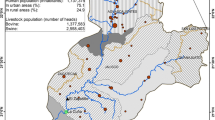Abstract
The methodology of materials accounting is presented and applied to developing nutrient balance (nitrogen and phosphorus) in a river basin. The method is based on the balance principle: inputs and outputs of each nitrogen and phosphorus related sub-systems were balanced. The application of the methodology strategies was illustrated by means of a case study of the Krka river, Slovenia. Different pathways of emission to surface waters were taken into account: WWTP discharges, direct discharges, erosion/runoff and baseflow. Total annual emission into the river Krka was estimated to be 362 tonnes N/year and 73.3 tonnes P/year. The main sources of nitrogen are diffuse sources, emitted via baseflow (52%). Other important sources are effluents from WWTP, which account for 36% of total emissions. Other sources like erosion and direct discharges to surface water (animal manure, industry, households) are of lower magnitude. Erosion is main source of phosphorus emission (55% of total emission), WWTP effluents account for 37% of total emission, while other sources are less important. Besides reduction of point sources by means of wastewater collection and implementation of nutrient removal technology, managing agricultural nitrogen and phosphorus to protect water quality should become a major challenge in the Krka river basin.
Similar content being viewed by others
References
Baccini, P., & Brunner, P. (1991). Metabolism of the Antroposphere. Berlin: Springer.
Bowes, M. J., House, W. A., & Hodgkinson, R. A. (2003). Phosphorus dynamics along a river continuum. Science of the Total Environment, 313, 199–212.
Bowes, M. J., House, W. A., Hodgkinson, R. A., & Leach, D. V. (2005). Phosphorus discharge hysteresis during storm events along a river catchment: The River Swale, UK. Water Research, 39, 751–762.
CEN CENELEC (2005). EN ISO/IEC 17025—General requirements for the competence of testing and calibration laboratories. Geneva: ISO.
Danube Applied Research Program (1997). Nutrient Balances for Danube Countries—Final Report-Project EU/AR/102A/91, Institute for Water Quality and Waste Management, Vienna University of Technology and the Department of Water and Wastewater Engineering; Vienna.
Dojlido, J., & Best, G. (1993). Chemistry of water and water pollution. Chichester: Ellis Horwood.
Drolc, A., Cotman, M., & Roš, M. (2003). Uncertainty of chemical oxygen demand determination in wastewater samples. Accreditation and Quality Assurance, 8, 138–145.
Drolc, A., & Roš, M. (2002). Evaluation of measurement uncertainty in the determination of total phosphorus using standardized spectrometric method ISO 6878. Acta Chimica Slovenica, 49, 409–423.
Drolc, A., Roš, M., & Cotman, M. (2004). Establishment of traceability of ammonium nitrogen determination in wastewater. Analytical and Bioanalytical Chemistry, 378, 1243–1250.
Drolc, A., & Zagorc Koncan, J. (2002). Estimation of sources of total phosphorus in a river basin and assessment of alternatives for river pollution reduction. Environment International, 28, 393–400.
Drolc, A., Zagorc Koncan, J., & Cotman, M. (2001). Evaluation of total nitrogen pollution reduction strategies in a river basin:A case study. Water Science and Technology, 44, 55–62.
Grant, R., & Blicher-Mathiesen, G. (2004). Danish policy measures to reduce diffuse nitrogen emissions from agriculture to the aquatic environment. Water Science and Technology, 49, 91–99.
ISO (1984a). International standard ISO 5663 — Water Quality — Determination of Kjeldahl nitrogen — Method after mineralization with selenium. ISO: Geneva.
ISO (1984b). International standard ISO 5664 — Water Quality — determination of ammonium — Distillation and titration method. ISO: Geneva.
ISO (1989). International standard ISO 6060 — Water quality — Determination of the chemical oxygen demand. ISO: Geneva.
ISO (1995). International standard EN ISO 10302 — Water quality — Determination of dissolved anions by liquid chromatography of ions. ISO: Geneva.
ISO (1997). International standard 11923 — Water quality — Determination of suspended solids by filtration through glass-fibre filters. ISO: Geneva.
ISO (1998). International standard ISO 6878 — Water quality — Spectrometric determination of phosphorus using ammonium molybdate. ISO: Geneva.
Kersebaum, K. C., Steidl, J., Bauer, O., & Piorr, H. P. (2003). Modelling scenarios to assess the effects of different agricultural management and land use options to reduce diffuse nitrogen pollution into the river Elbe. Physics and Chemistry of the Earth, 28, 537–545.
Novotny, V. (1995). Nonpoint pollution and urban stormwater management. Technomic: Lancaster.
Novotny, V. (1999). Diffuse pollution from agriculture — A worldwide outlook. Water Science and Technology, 39, 1–13.
Snook, D. L., & Whitehead, P. G. (2004). Water quality and ecology of the River Lee: Mass balance and a review of temporal and spatial data. Hydrology and Earth System Sciences, 8, 636–650.
Somlyody, L., Brunner, P. H., & Kroiss, H. (1999). Nutrient balances for Danube countries: A strategic analysis. Water Science and Technology, 40, 9–16.
Vagstad, N., Stalnacke, P., Andersen, H. E., Deelstra, J., Janson, V., Kyllmar, K., et al. (2004). Regional variations in diffuse nitrogen losses from agriculture in the Nordic and Baltic regions. Hydrology and Earth System Sciences, 8, 651–662.
Veselic, M., Pintar, M., Drolc, A., Vižntin, G., Cencur Curk, B., Ros, M., et al. (2001). River basin water nitrate quality management with respect to the existing data structures. In R. A. Falconer & W. R. Blain (Eds.), River basin management. WIT: Southampton.
Withers, P. J. A., & Jarvis, S. C. (1998). Mitigation options for diffuse phosphorus loss to water. Soil Use and Management, 14, 186–192.
Zessner, M., Kaas, T., Brunner, P. H., & Fleckseder, H. (1996). Regional materials accounting of nitrogen in upper Austria. Water Science and Technology, 33, 89–94.
Author information
Authors and Affiliations
Corresponding author
Rights and permissions
About this article
Cite this article
Drolc, A., Zagorc Koncan, J. & Tisler, T. Evaluation of Point and Diffuse Sources of Nutrients in a River Basin on Base of Monitoring Data. Environ Monit Assess 129, 461–470 (2007). https://doi.org/10.1007/s10661-006-9376-5
Received:
Accepted:
Published:
Issue Date:
DOI: https://doi.org/10.1007/s10661-006-9376-5




